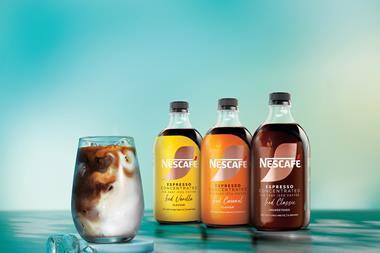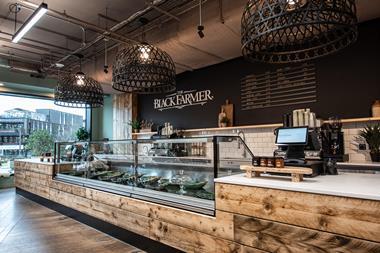Paul Grimwood is pumping £43m into reviving the instant coffee as he re-energises Nestlé UK, says Adam Leyland
It's almost 20 years since the last of the Gold Blend soap opera ads, when Anthony Head declared his undying love for Sharon Maughan in front of a roasting fire. And Paul Grimwood, Nestlé UK and Ireland's newish CEO, is desperate to rekindle that old advertising magic.
Nescafé "has been advertising", he admits, "but it's not been groundbreaking or memorable. We need to get back to iconic campaigning."
Next week Grimwood hopes his wishes are fulfilled when Nestlé launches a whopping £43m ad campaign for the instant coffee brand. Grimwood's face lights up as he describes the campaign Coffee at its Brightest. "It's not just TV and print, it's what you can do digitally now that's so exciting."
The strong creative is welcome and timely not just as relief from the endless insurance website commercials, but because Nescafé is back in fashion. Since Starbucks brought us skinny lattes and dry cappuccinos with an extra shot, Nescafé has been poor relation, and sales stalled.
But with recession, consumer spending habits have changed markedly. And judging by the size of the ad budget, Grimwood believes there's a greater opportunity to be exploited. Instant coffee is growing 7.1%, with Nescafé sales up 4.2% [all figures are IRI year-to-date unless otherwise stated].
"Nescafé is doing really well," he says. "It's a trusted brand, which fits well with the climate, but it's also about people taking a flask to work instead of buying on the go."
Perhaps more surprising, in the latest half-yearly results announced by Nestlé earlier this month, were the strong performances of its fancy at-home coffee systems, Nespresso and Dolce Gusto. Grimwood reports sales of Nespresso up 40% and Dolce Gusto pods up 36%. "You think, at first, wow, but it's obvious: people say 'I'm not going to go out and spend £2 on a coffee; I'll make it at home."
Coffee is one of a number of strong performers in the latest results. In the confectionery division, Kit Kat sales are up a further 7% following a 19% rise last year. And Randoms has been a fantastic riposte to the success of Cadbury's Natural Confectionery Company, with sales of £3.5m since its launch in May. Grimwood has just increased media spend by a further £2m, to £5.6m.
Other highlights include the dairy yoghurts division, with sales of Munch Bunch up 25%. Even Ski yoghurt, which has had more makeovers than Madonna, is finally enjoying success again, with sales up 11%.
As to waters, Grimwood professes himself pleased, with strong growth for the UK-sourced brands, Buxton and Nestlé's most recent launch, Pure Life.
"It's not been a great summer for water, but the headlines are exaggerated. Overall, sales are flat. But the consumer's not stupid. Water is more healthy than a lot of other drinks, and there aren't too many taps on the M6."
In fact, the only downer right now the failure of last year's Boost Smoothies joint venture a dim memory is vending. "The same trend that is encouraging consumers to bring a flask of coffee to work or to make a packed lunch is eating into the market," says Grimwood. "Fortunately, Nestlé is in a huge number of categories. I wouldn't want to be exclusively in vending; or relying on Icelandic water sales."
Nonetheless, there is pressure on the business, as the latest global results show (The Grocer, 15 August, p5). In a tough trading environment, and with 22% group operating profit margins the envy of most rivals, supermarkets have raised more than an eyebrow. But Grimwood, while "pleased with the overall profitability of the UK business", defends Nestlé's margin position vigorously.
"The high multiples relate mostly to the nutrition and health businesses. Our food margins are OK. It's where we've leveraged R&D that we've moved those margins. Nestlé makes good margins fundamentally because it adds value. Our products are ahead of the game. Consumers won't overpay, but if you give them what they want, they will pay."
Nowhere has Nestlé's leveraging of R&D been more keenly felt in the UK than in Grimwood's transformation of the confectionery business. Returning from Nestlé's Swiss HQ in 2005 to his home town, York, it was a sort of homecoming.
But the former Rowntrees business had lost its way, with KitKat launching a thoughtless stream of new flavours, like a celebrity chef gone mad symptomatic of a wider malaise.
Nostalgia was quickly put to one side as Grimwood first got to grips with costs, and specifically the eccentric York factory. Sitting side-by-side with state-of-the-art facilities was machinery that resembled a Victorian museum. Closing this half of the factory, he was able to retain 80% of the capacity, transferring the remainder to other plants in the UK and Europe.
He also tackled the quality side. "With modern automated machinery," he says, "you are producing hundreds of millions of bars, but these are not just widgets. Chocolate can vary from season to season, and it takes a lot of skill and hard work to maintain consistency at all times."
Only at "stage four" did Grimwood look at new product development, focusing on seven core brands, which he called 'The Magnificent Seven'. And chief among these was KitKat. "The British public adored the brand. But we had played around with a best friend, and they didn't like that," Grimwood admits.
This time the team focused on identifying genuine gaps in the market. "I've lost count of the testing we did before we came up with KitKat Senses," he recalls.
Grimwood is keen to raise Nestlé's profile. "We have a very strong portfolio of brands, but we've not linked it all up and told people about it."
But the biggest push is advertising. Having built the foundations the fun can begin. "When you have put in the groundwork, you've got to then support the brands. And this is the time to invest. You have a bigger bang for your buck. The media planners love us."
Sign in to comment on this article
Not logged in before? Register for FREE guest access today.
You will be able to:
- Read more stories
- Receive daily newsletters
- Comment on stories
Advert
















No comments yet